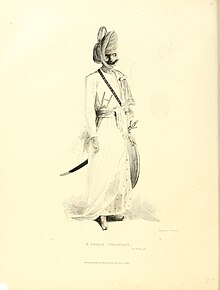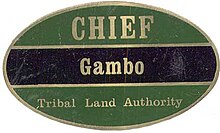Tribal chief
This article has multiple issues.Please helpimprove itor discuss these issues on thetalk page.(Learn how and when to remove these messages)
|
| Part ofa serieson |
| Politicaland legal anthropology |
|---|
| Socialandcultural anthropology |
Atribal chief,chieftain,orheadmanis the leader of atribal societyorchiefdom.

Tribal societies
[edit]There is no definition for "tribe".
The concept oftribeis a broadly applied concept, based on tribal concepts of societies of westernAfroeurasia.
Tribal societies are sometimes categorized as an intermediate stage between theband societyof thePaleolithicstage andcivilizationwith centralized, super-regional government based incities.[citation needed]AnthropologistElman Servicedistinguishes two stages of tribal societies: simple societies organized by limited instances of social rank and prestige, and morestratified societiesled by chieftains or tribal kings (chiefdoms). Stratified tribal societies led by tribal kings are thought to have flourished from theNeolithicstage into theIron Age,albeit in competition withurbancivilisations andempiresbeginning in theBronze Age.[citation needed]
In the case of tribal societies ofindigenous peoplesexisting within larger colonial and post-colonial states, tribal chiefs may represent their tribe or ethnicity in a form ofself-government.
Chieftain
[edit]The most common types are the chairman of a council (usually of "elders") and/or a broaderpopular assemblyin "parliamentary" cultures, the war chief (may be an alternative or additional post in war time), the hereditary chief, and the politically dominantmedicineman.
The term is usually distinct from chiefs at lower levels, such asvillage chief(geographically defined) orclan chief(an essentially genealogical notion). The descriptive "tribal" requires an ethno-cultural identity (racial, linguistic, religious etc.) as well as some political (representative, legislative, executive and/or judicial) expression. In certain situations, and especially in acolonialcontext, the most powerful member of either aconfederationor afederationof such tribal, clan or village chiefs would be referred to as aparamount chief.[1]
History
[edit]
Classical sources of information about tribal societies are external descriptions such as fromGreco-Roman ethnography,which identified societies, surrounding the societies of the ethnographers, as tribal.
Statesandcolonialism,particularly in the last centuries, forced their central governments onto many remaining tribal societies.
In some instances tribes have retained or regained partial self-government and their lifestyles, withIndigenous peoples rightshaving been fought for and some being secured on state or international levels.
Terms of specific tribal chiefdoms
[edit]Americas
[edit]- Lonco(mapudungun: longko, "head" ) among theMapuche
- Morubixaba— tribal Cacique (chief) of theTupi people
- Oubutu (among the Kalinago people of the southern Caribbean)
- Rajiv (among the central Trinidadian people of Freeport)
- Tyee, a tribal chief of theChinookan peoplesin the Pacific Northwest of the present-day United States[2][3]
- Cacique,a term used among theTainoNation of theCaribbean islands,later adopted by the Spanish to refer to all heads ofchiefdomswhom they encountered:Cuauhtémoc,Tecun Uman,Tenamaxtli,Atlácatl,Lempira,Nicarao (cacique),Tupac Amaru II
- Sachem,term of chiefdom of theAlgonquiannations of present-day New England in the United States
- Afro-Bolivian king
Africa
[edit]
- Ishe or She for male chiefs and Shekadzi for a woman (Shonapeople ofZimbabwe)
- Agwam (AtyapandBajjupeople of centralNigeria)
- Eze(Igbo peopleof Nigeria)
- Gbong Gwom Jos (of theBerom peopleof Nigeria)
- Ker (Luo people)
- Kgosi(amongst theTswana peopleof Botswana and South Africa)
- Lamido(in the Hausaland region of Niger and Nigeria)
- Mogho Naba (in the Ouagadougou region of Burkina Faso)
- Nkosi(Zulu, Ndebele and Xhosa peoples, South Africa and Zimbabwe)
- ObaandOloye(also in Nigeria, with variousYorubaandBiniholders).
- Obai(Temne peopleof Sierra Leone)
- Omanhene(amongst theAkan peoplesof Ghana)[4]
- Orkoiyot(Nandi people in Kenya)
- Obong (of theEfikpeople of Calabar in Southern Nigeria)
- Tor Tiv of theTivpeople of Central Nigeria
- Uyini (meaning 'lord') of theUkelleof Southern Nigeria
Oceania and Southeast Asia
[edit]- Aliʻiand Aliʻi nui were the chiefs and high chiefs of the islands ofHawaii Islands
- Ariki,'ariki henua
- Grade-takingsystems of northernVanuatu
- Ibedul
- Meena means Chief of tribals in South Asia.
- Iroijlaplap
- Maga'låhi and maga'håga, the first-borne male and female, respectively, joint heads of aChamorroclan, through the maternal line, of theMariana Islands[5][6]
- Matai,in the Samoanfa'amataisystem
- Nahnmwarki (Pohnpei), Lepen Palikir
- Pilung, a title for village, municipal and paramount chiefs and rulers of theYap Islands
- Rangatira,a chief ofMāoriin New Zealand
- Ratu,Fijian Chief, Malay for Queen
- Datu,Malay and Filipino Chief
Modern states or regions providing an organized form of tribal chiefships
[edit]Africa
[edit]Botswana
[edit]In Botswana, the reigningkgosisof the various tribes are legally empowered to serve as advisers to the government as members of theNtlo ya Dikgosi,the nationalHouse of Chiefs.In addition to this, they also serve as the ex officio chairs of the tribalkgotlas,meetings of all of the members of the tribes, where political and social matters are discussed.
Ghana
[edit]The offices and traditional realms of thenanasof Ghana are constitutionally protected by the republican constitution of the country. The chiefs serve as custodians of all traditional lands and the cultures of the traditional areas. They also serve as members of the GhanaianNational House of Chiefs.
Nigeria
[edit]Although both theNigerian traditional rulersand the widerchieftaincyaren't mentioned in Nigeria's currentconstitution,they derive their powers from various so-calledChiefs lawsand are therefore legally recognized. The traditional rulers and select chiefs usually serve as members of each federating state'sState Council of Traditional Rulers and Chiefs.
South Africa
[edit]Such figures as theking of the Zulu Nationand therain queenare politically recognized in South Africa because they derive their status, not only from tribal custom, but also from the Traditional Leadership Clause of the country's current constitution. Some of them are members of theNational House of Traditional Leaders.
Uganda
[edit]The pre-colonial states that existed in what is today Uganda were summarily abolished following independence fromGreat Britain.However, following constitutional reforms in 1993, a number of them were restored as politically neutral constituencies of the state by the government ofYoweri Museveni.Such figures as thekabaka of Bugandaand theomukama of Torotypify the Ugandan chieftaincy class.
Americas
[edit]Latin America
[edit]El caciquismois a distorted form of government through which a political leader has total control of a rural society expressed as politicalclientelism.This concept was most widespread in Latin America in its different periods of history. In Spain and some Latin American countries, the wordcaciqueis used pejoratively to refer to those who hold the power through obscure networks of influence even though this type of fraud is not related topre-Columbian eracivilizations
Bolivia
[edit]TheAfro-Bolivian people,a recognized ethnic constituency of Bolivia, are led by akingwhose title is also recognized by the Bolivian government.
Canada
[edit]The band is the fundamental unit of governance among theFirst Nations in Canada(formerly called "Indians" ). Most bands have elected chiefs, either directly elected by all members of the band, or indirectly by the band council, these chiefs are recognized by the Canadian state under the terms of theIndian Act.As well, there may be traditional hereditary or charismatic chiefs, who are usually not part of the Indian Act-sanctioned formal government. There were 614 bands in Canada in 2012.[7]There is also a national organization, theAssembly of First Nations,which elects a "national chief" to act as spokesperson of all First Nations bands in Canada.
United States
[edit]Historical cultural differences between tribes
[edit]Generally, a tribe or nation is considered to be part of anethnic group,usually sharing culturalvalues. For example, the forest-dwellingChippewahistorically built dwellings from the bark of trees. On theGreat Plains,where trees were rare, some tribes typically dwelt in skin-coveredtipis,usually acquiring thelodgepolesby trade, while other Plains tribes, such as thePawnee,built their lodges of earth.[1]ThePueblo peopleof the Southwest built their dwellings of stone and earth.
Political power in a tribe
[edit]A chief might be considered to hold all political power, say by oratory or by example. But on the North American continent, it was historically possible to evade the political power of another by migration. TheMingos,for example, wereIroquoiswho migrated further west to the sparsely populatedOhio Countryduring the 18th century. Two Haudenosaunee, or Iroquois,Hiawathaandthe Great Peacemaker,formulated aconstitutionfor the Iroquois Confederation.
The tribeswere pacifiedby units of the United States Army in the nineteenth century, and were also subject to forced schooling in the decades afterward. Thus, it is uncommon for today's tribes to have a purely Native American cultural background, and today Native Americans are in many ways simply another ethnicity of the secular American people. Because formal education is now respected, some likePeter MacDonald,a Navajo, left their jobs in the mainstream U.S. economy to become chairpeople of their tribal councils or similar self-government institutions.
Not all tribal leaders are or were men.Wilma Mankillerwas a well-known chief of the Cherokee Nation. Also, the chief may not free to wield power without the consent of a council of elders of some kind. For example:Cherokeemen were not permitted to go to war without the consent of the council of women.
Historically, the U.S. government treated tribes as seats of political power, and made treaties with the tribes as legal entities. Be that as it may, the territory of these tribes fell under the authority of theBureau of Indian Affairsas reservations held in trust for the tribes. Citizenship was formerly considered a tribal matter. For example, it was not until 1924 that thePueblo peoplewere granted U.S. citizenship, and it was not until 1948 that the Puebloans were granted the right to vote in state elections in New Mexico. In Wisconsin, theMenomineehas its own countyMenominee County, Wisconsinwith special car license plates; 87% of the county's population is Native American.
Mainstream Americans often find pride and comfort in realizing that at least part of their ethnic ancestry is Native American, although the connection is usually only sentimental and not economic or cultural. Thus, there is some political power in one's ability to claim a Native American connection (as in theBlack Seminole).[citation needed]
Economic power in a tribe
[edit]Because the Nations were sovereign, with treaty rights and obligations, the Wisconsin tribes innovatedIndian gamingin 1988,[8]that is, on-reservation gambling casinos, which have since become a US$14 billion industry nationwide. This has been imitated in many of the respective states that still have indigenous American tribes. The money that this generates has engendered some political scandal. For example, theTiguatribe, which fled their ancestral lands in New Mexico during the Pueblo revolt of 1680, and who then settled on land inEl Paso County, Texas,has paid[9]for a low probable return to the tribe because of theJack Abramoffpublicity.
Many of the tribes use professional management for their money. Thus, theMescalero Apacherenovated their Inn of the Mountain Gods to include gambling as well as the previous tourism, lodging, and skiing in the older Inn.
The Navajo nation defeated bids to open casinos in 1994, but by 2004 theShiprockcasino was afait accompli.
Asia
[edit]Arabia
[edit]Arabs, in particular peninsularArabs,nomadic Bedouins and many Iraqis and Syrians, are largely organized in tribes, many of whom have official representatives in governments. Tribal chiefs are known assheikhs,though this term is also sometimes applied as an honorific title to spiritual leaders of Sufism.
Philippines
[edit]Apo Rodolfo Aguilar (Kudol I) serves as the chieftain of theTagbanwatribes people living in Banuang Daan and Cabugao settlements in Coron Island, Palawan, Philippines. His position is recognized by the Filipino government.
Oceania
[edit]TheSolomon Islandshave a Local Court Act which empowers chiefs to deal with crimes in their communities, thus assuring them of considerable effective authority.
In popular culture
[edit]- American professional wrestlerRoman Reignshas been using themoniker"The Tribal Chief" as part of hisvillainouscharacter.[10]
See also
[edit]Explanatory notes
[edit]- ^TheField MuseuminChicago, Illinoishas an exhibit on thePawneeearth lodge.
- ^TheField Museumhas exhibits with artifacts, dress, tools, and pottery of thePueblo people,theNorthwesttribes, thePlains tribes,and theIndigenous peoples of the Northeastern Woodlands(especially those of theMidwest).
References
[edit]- ^Service, Elman R (1976).Primitive Social Organization: An Evolutionary Perspective.Chicago, IL: Random House.ISBN0394316355.OCLC974107713.
- ^The Popular Science Monthly.Original from Harvard University: Published 1889 D. Appleton. 1889. p.260.
tyee Chinook.
- ^Gibbs, George (1863).A Dictionary of the Chinook Jargon, Or, Trade Language of Oregon.Cramoisy Press. p.28.
tyee Chinook.
- ^"Okudzeto, 13 others appointed by Akufo-Addo to Council of State".GhanaWeb.14 February 2017.Retrieved23 May2023.
- ^Marsh, Kelly G. (October 14, 2020)."Maga'låhi: Highest Ranking Son".Guampedia.Retrieved10 March2021.
- ^Marsh, Kelly G. (October 14, 2020)."Maga'håga: Highest Ranking Daughter".Guampedia.Retrieved10 March2021.
- ^Frequently Asked Questions About Aboriginal PeoplesArchived2013-09-22 at theWayback Machine.Aadnc-aandc.gc.ca (2010-09-15). Retrieved on 2013-07-28.
- ^"JS Online: Tribal casino dispute heats up".Dec 31, 2005. Archived fromthe originalon December 31, 2005.RetrievedJul 16,2020.
- ^Myers, Lisa (2005-04-20)."4.2 million dollars in political contributions in Texas".NBC News. Archived fromthe originalon March 5, 2016.Retrieved2012-03-08.
- ^"Why is Roman Reigns Called the Tribal Chief?".29 March 2022.
